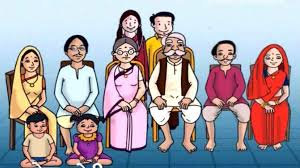Indian Legal System > Civil Laws > Family Laws > Family > Kinds of Family
Family is one of the most important social institutions. It is the most pervasive and universal social institution. They usually share common residence, at least for some part of their lives. There is the relational aspect among the members. Members have reciprocal rights and duties towards each other. In this article, we shall study different kinds of families on various basis.
Kinds of Families On the Basis of Authority:
Patriarchal Family:

Patriarchal families are commonly found in all parts of the world since most societies in the world are patrilineal societies. It is a form of family in which authority is centered in the husband or father. In patriarchal families, the head of the family is a male, and authority is vested in him. He is instrumental in making all the decisions on behalf of the family. He is the administrator of the family and presides over all the religious rites of the family. He is assumed to be protector and ruler of the family and has control over all the members of the family. Descent and property are passed through the male line and children are brought up in father’s house. Such families are patrilocal in nature.
In olden days such families were prevalent amongst the Hebrews, the Romans, the Greeks, and the Aryans.
Characteristics of Patriarchal Society:
- In a patriarchal system, the father is the supreme lord of the family property. He makes all decisions in both society and in his family unit, holds all positions of power and authority, and are considered superior. He presides over all the religious rites of the family.
- After marriage, the wife comes to live in the husband’s and in-laws home. She has to bear the surname of her husband and forfeit maiden surname. Head of the family is assumed to be protector and ruler of the family and has control over all the members of the family.
- The descent is reckoned through the father, and the children are known by the name of the family of father. Children are brought up in father’s house.
- The children often inherit the property of the father only and is generally passed through the male line
Matriarchal Family:
Matriarchal families are found only in matrilineal societies, which are very limited in number all over the world. They are found in parts of Latin America, Ceylon, parts of Africa and India (the Khasis and the Garos tribes of Assam and Meghalaya, among Nayars of Malabar in Kerala). It is a form of family in which authority is centered in the wife or mother. In a matriarchal family, a woman is the head of the family, and authority is vested in her. After marriage, the husband resides in the wife’s house and descent is traced through the mother’s side. Here, children are brought up in mother’s house. Descent and property is passed through the female line and children are brought up in mothers’s house. Such families are matrilocal in nature.
Characteristics of Matriarchal Society:
- In a matriarchal system, the mother is the supreme lord of the family property. She makes all decisions in both society and in her family unit, hold all positions of power and authority, and are considered superior.
- After marriage, the husband comes to live in the wife’s and in-laws home.
- The descent is reckoned through the mother, and the children are brought up in mother’s house.
- The children often inherit the property of the mother only and is generally passed through the female line
Kinds of Families On the Basis of Structure:
Nuclear Family:

A nuclear family is a small group consisting of a husband, a wife, and children, natural or adopted. It is the smallest composite autonomous family unit. It is free from the control of adults or elders of the family. It consists of two generations only. The children leave their parental home as soon as they are married. Separate residence ensures a physical distance between parents and married children. In all modern societies, the nuclear family is the most common type of family. A typical American family is an example of a nuclear family. The disintegration of the joint family system is resulting in nuclear families.
Extended Family:
Extended family comes into existence due to a merger of several nuclear families. It may include a husband and his wife, their unmarried daughters, their married sons, their wives, and their unmarried children. They may live together in the same house or may occupy a cluster of houses within the same locality. Such type of families is large in size compared to the nuclear family. The eldest male is the head of the family and all adult members share responsibilities of household tasks. Such families are good for children. Children enjoy the care, attention of elders. Children learn to adjust to persons of varying age levels and with persons of different attitudes. They also learn some qualities like co-operation, sympathy, etc. at an early age. This system may make the children more dependent and they may lose self-confidence, self-reliance, and initiative.
The difference between the nuclear family and the extended family is that a nuclear family refers to a single basic family unit of parents and their children, whereas the extended family refers to their relatives, as well – such as grandparents, in-laws, aunts, and uncles, etc. The extended family is continuous while the nuclear family is not. A nuclear family comes to an end when one of the parents dies. The nuclear family is independent while the extended family is run by the eldest person in the family.
Joint Family:
A joint family is a form of an extended family consists of three or more generations, living together under the same roof, sharing the same kitchen and purse or economic expenses. It is a family consisting of three nuclear families living together. They are blood relatives or close kins. A Hindu Undivided Family (HUF) is the best example of a joint family. In patriarchal families, only unmarried daughters, or at times widowed daughters are a part of the family. Married daughters no longer belong to the family as they become a part of their husband’s family. However, in the case of matriarchal joint families daughters are a part of the joint family, whereas sons become a part of their wives’ families.
Kinds of Families On the Basis of Residence:
Matrilocal Family:
In this system, after marriage, the husband resides in the wife’s house and descent is traced through the mother’s side. Here, children are brought up in wife’s mother’s house.
Patrilocal Family:
In this system, after marriage, the wife resides in the husband’s house and descent is traced through the father’s side. Here, children are brought up in husband’s father’s house.
Bilocal:
In this system, the couple decides to live with the parents of either the groom or the bride. When a family stays in the husband’s house for some time and moves to the wife’s house, stays there for a period of time, and then moves back to the husband’s parents.
Family Changing Residence:
In this system, the couple decides to live with the parents of either the groom or the bride. When a family stays in the husband’s house for some time and moves to wife’s house, stays there for a period of time, and then moves back to husband’s parents, or starts living in another place, the family is called a family of changing residence.
Avunculocal:
The word ‘avuncu’ means maternal uncle i.e. the brother of the mother. In this system, the couple lives in maternal uncle’s house after their marriage.
Neo-local:
Here, the husband and wife live in separate residences, which are usually close to their respective jobs. These families are found in West and developed nations in which both the husband and the wife are career-minded and work in different cities. In such a case, the husband may spend a weekend at the wife’s home and vice versa.
The marriage couple stays in a completely new residence neither in the groom’s family nor in the bride’s family. They can also fall under changing residence families.
Kinds of Families On the Basis of Marriage:
Monogamous Family:
In this system, the family consists of one husband and one wife, including children and is based on monogamous marriages. Under the Christian, the Parsi, and the Hindu Marriage Acts, neither the husband nor the wife can marry again in the lifetime of his or her spouse.
Polygamous Family:
In this system A family consisting of one husband, and his more than one wife at the same time. This type of family has its basis in the polygamous form of marriage. It is practiced by Muslims.
Polyandrous Family:
A family made up of one wife and her more than one husband at the same time. This family is based on polyandrous marriage. It is followed in some parts of Assam.
Kinds of Families On the Basis of Ancestry or Descent or Lineage:
Matrilineal Family:
When ancestry or descent is traced through the female line, or through the mother’s side, the family is called matrilineal family. In such a system the rights of members of the family depend on such member’s relationship with the mother. The members inherit property and titles from the female line.
Patrilineal Family:
A family in which the authority is carried down the male line and descent is traced through the male line or the father’s side is called a patrilineal family. In such a system the rights of members of the family depend on such member’s relationship with the father. The members use the father’s surname and inherit property and titles from the male line.
Kinds of Families On the Basis of Blood Relations:
Conjugal Family:
It refers to a family system of spouses and their dependent children. The emphasis is placed on the marital relationship that exists between spouses. In modern times, the term ‘conjugal family’ is being used for partners, who have a long- term sexual relationship but are not actually married.
Consanguine Family:
A consanguine family is made up of members among whom a blood relation exists, or those who are consanguineal kin, i.e., a family consisting of parent(s) and children, or siblings (brothers, sisters, or brothers and sisters).
Other Forms of Family:
Single Parent Family
The single-parent family consists of one parent raising one or more children on his own. This family may include a single mother with her children, a single dad with his kids, or a single person with their kids.

One reply on “Kinds of Families”
Wow